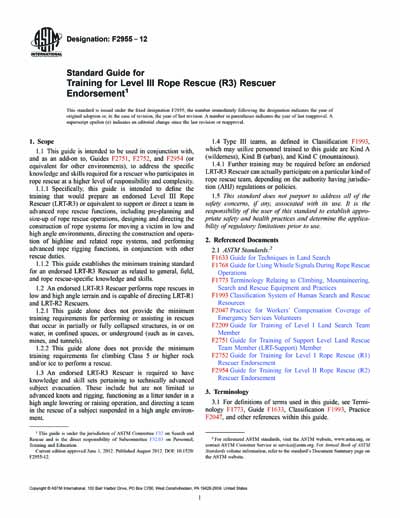Historical
ASTM F2955-12
Standard Guide for Training for Level III Rope Rescue (R3) Rescuer Endorsement
1.1 This guide is intended to be used in conjunction with, and as an add-on to, Guides F2751, F2752, and F2954 (or equivalent for other environments), to address the specific knowledge and skills required for a rescuer who participates in rope rescue at a higher level of responsibility and complexity.
1.1.1 Specifically, this guide is intended to define the training that would prepare an endorsed Level III Rope Rescuer (LRT-R3) or equivalent to support or direct a team in advanced rope rescue functions, including pre-planning and size-up of rope rescue operations, designing and directing the construction of rope systems for moving a victim in low and high angle environments, directing the construction and operation of highline and related rope systems, and performing advanced rope rigging functions, in conjunction with other rescue duties.
1.2 An endorsed LRT-R3 Rescuer performs rope rescues in low and high angle terrain and is capable of directing LRT-R1 and LRT-R2 Rescuers.
1.3 An endorsed LRT-R3 Rescuer is required to have knowledge and skill sets pertaining to technically advanced subject evacuation. These include but are not limited to advanced knots and rigging, functioning as a litter tender in a high angle lowering or raising operation, and directing a team in the rescue of a subject suspended in a high angle environment.
1.4 Type III teams, as defined in Classification F1993, which may utilize personnel trained to this guide are Kind A (wilderness), Kind B (urban), and Kind C (mountainous).
1.5 This standard does not purport to address all of the safety concerns, if any, associated with its use. It is the responsibility of the user of this standard to establish appropriate safety and health practices and determine the applicability of regulatory limitations prior to use.
ASTM International [astm]

